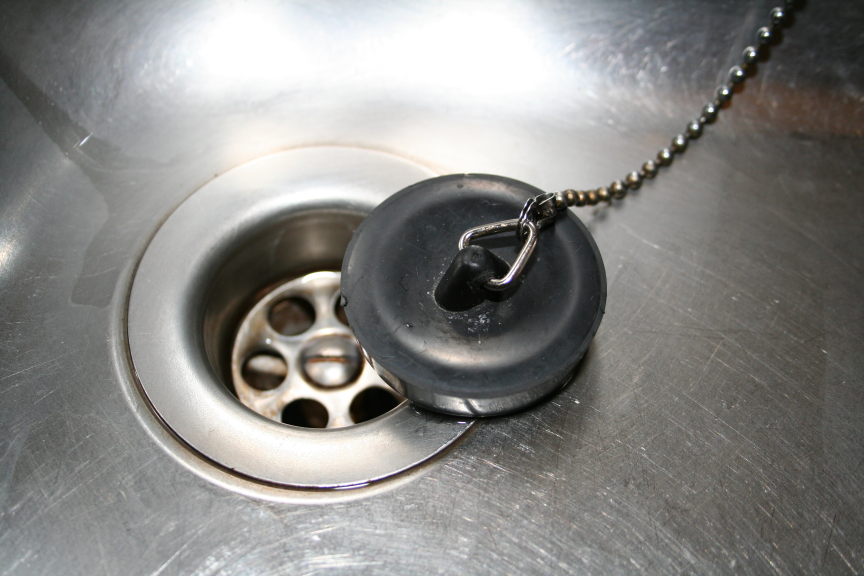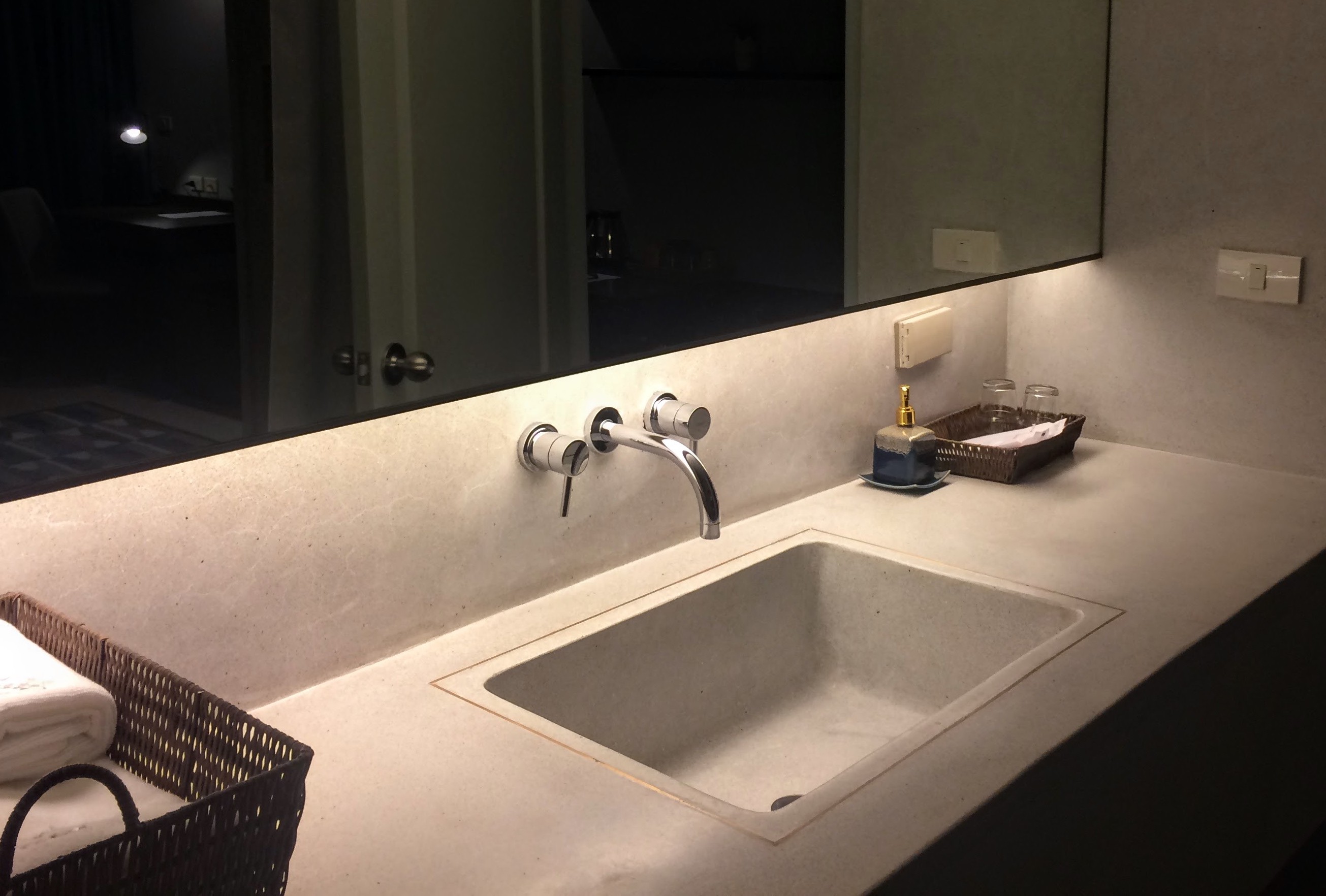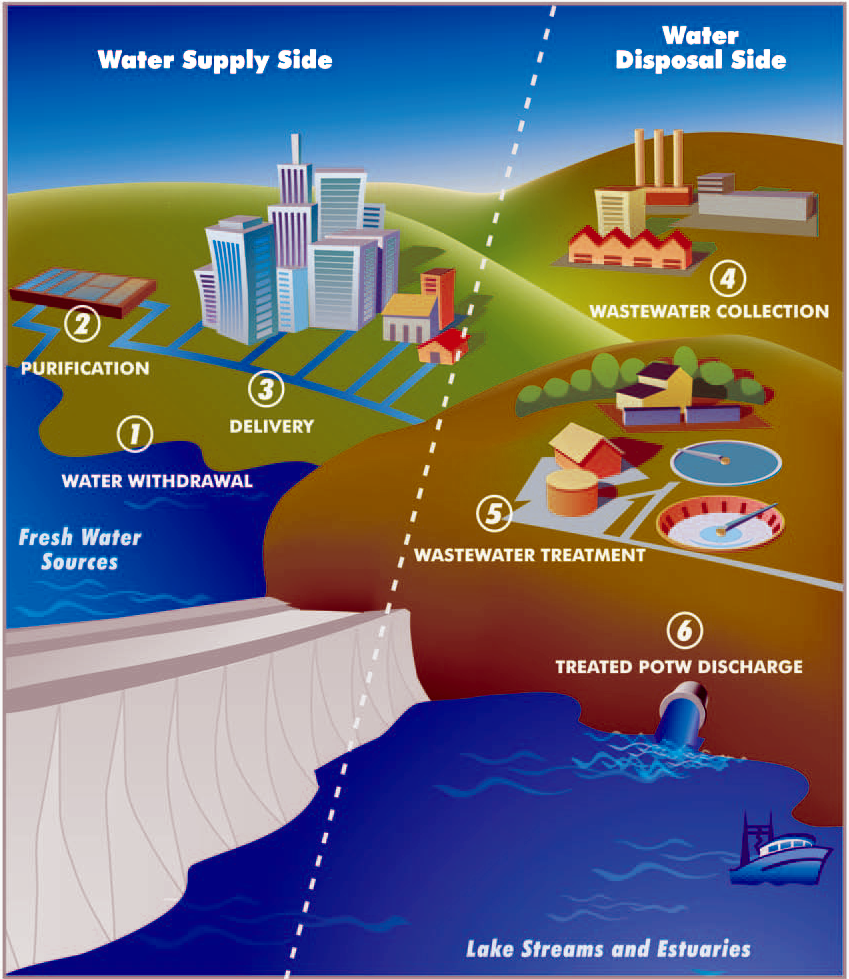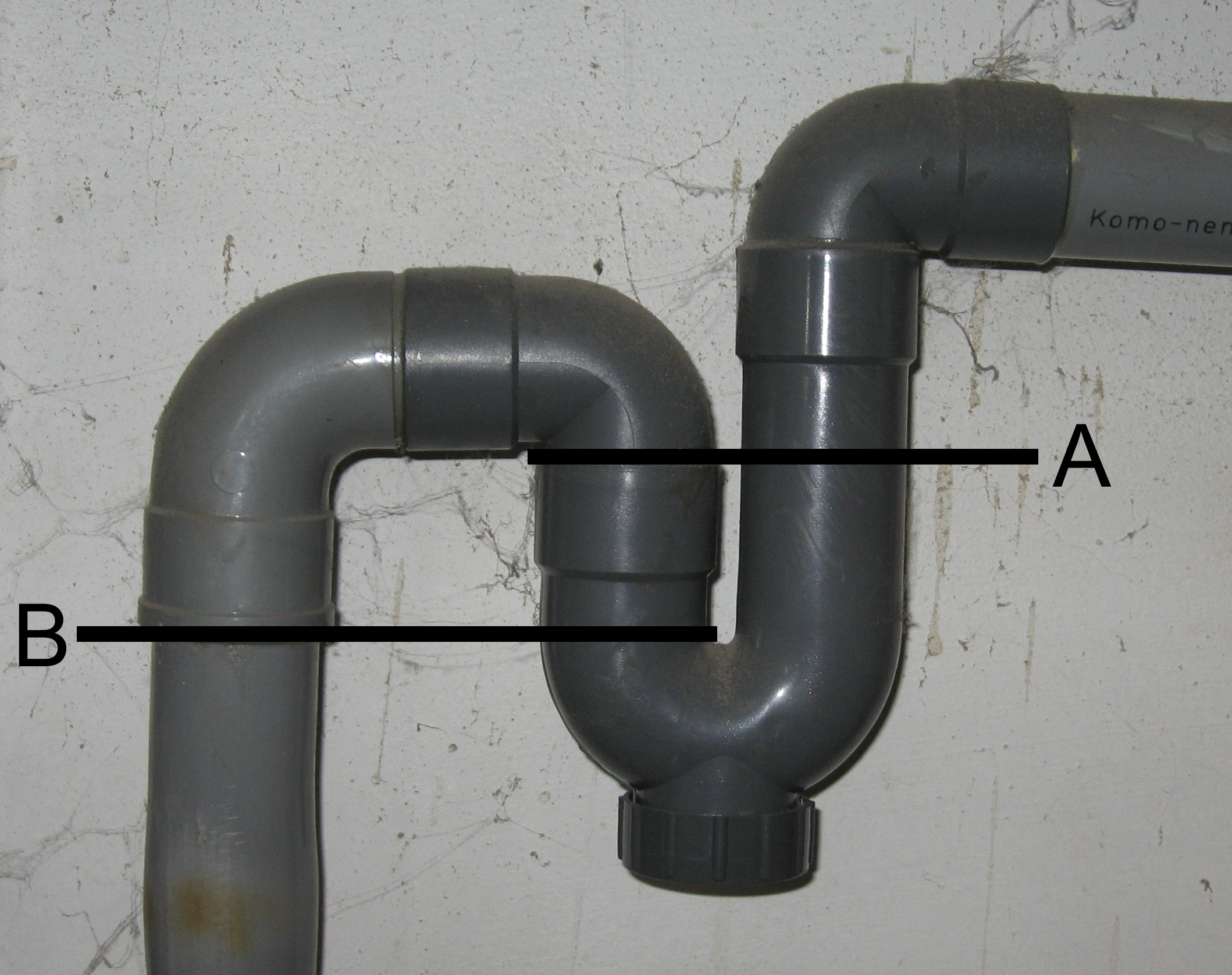|
Sink Strainer
In plumbing, a sink strainer is a type of perforated metal sieve or mesh strainer used to strain or filter out solid debris in the water system. Different varieties are used in residential premises and for industrial or commercial applications. Such strainer elements are generally made from stainless steel for corrosion resistance. Household use In houses, sink strainers are often used as drain covers in sinks, showers and bathtubs. Water lines or kitchen systems can get gravel, deposits that break free, and other stray items in the line. Due to the velocity of the water pushing them, they can severely damage or clog devices installed in the flow stream of the water line, for example p-traps or pipes. A strainer is essentially a screen installed to allow water to pass through, but not larger items. The larger items fall to the bottom or are held in a basket for later clean out. They normally have an access that allows for them to be cleaned or have the strainer plate or basket ... [...More Info...] [...Related Items...] OR: [Wikipedia] [Google] [Baidu] |
Colander
A colander (or cullender) is a kitchen utensil used to strain foods such as pasta or to rinse vegetables. The perforated nature of the colander allows liquid to drain through while retaining the solids inside. It is sometimes also called a pasta strainer or kitchen sieve. Description and history Traditionally, colanders are made of a light metal, such as aluminium or thinly rolled stainless steel. Colanders are also made of plastic, silicone, ceramic, and enamelware. The word ''colander'' comes from the Latin ''colum'', meaning sieve. Types of colanders * Bowl- or cone-shaped – the traditional colander * Mated colander pot Other uses The colander in the form of a pasta strainer was adopted as the religious headgear of the religion Pastafarianism in deference to the Flying Spaghetti Monster. See also * Chinois A chinois (; ) is a conical sieve with an extremely fine mesh. It is used to strain custards, purees, soups, and sauces, producing a very smooth texture. It ... [...More Info...] [...Related Items...] OR: [Wikipedia] [Google] [Baidu] |
Sink
A sink is a bowl-shaped plumbing fixture for washing hands, dishwashing, and other purposes. Sinks have a tap (faucet) that supply hot and cold water and may include a spray feature to be used for faster rinsing. They also include a drain to remove used water; this drain may itself include a strainer and/or shut-off device and an overflow-prevention device. Sinks may also have an integrated soap dispenser. Many sinks, especially in kitchens, are installed adjacent to or inside a counter. When a sink becomes clogged, a person will often resort to using a chemical drain cleaner or a plunger, though most professional plumbers will remove the clog with a ''drain auger'' (often called a " plumber's snake"). History United States The washstand was a bathroom sink made in the United States in the late 18th century.Sinks ''The Old-House Journal'' ... [...More Info...] [...Related Items...] OR: [Wikipedia] [Google] [Baidu] |
Water Filters
A water filter removes impurities by lowering contamination of water using a fine physical barrier, a chemical process, or a biological process. Filters cleanse water to different extents, for purposes such as: providing agricultural irrigation, accessible drinking water, public and private aquariums, and the safe use of ponds and swimming pools. Methods of filtration Filters use sieving, adsorption, ion exchanges, biofilms and other processes to remove unwanted substances from water. Unlike a sieve or screen, a filter can potentially remove particles much smaller than the holes through which its water passes, such as Nitrates or germs like ''Cryptosporidium.'' Among the methods of filtration, notable examples are sedimentation, used to separate hard and suspended solids from water and activated charcoal treatment, where the boiled water is poured through a piece of cloth to trap undesired residuals. Additionally, the use of machinery to work on desalinization and purificatio ... [...More Info...] [...Related Items...] OR: [Wikipedia] [Google] [Baidu] |
Water Supply Network
A water supply network or water supply system is a system of engineered hydrologic and hydraulic components that provide water supply. A water supply system typically includes the following: # A drainage basin (see water purification – sources of drinking water) # A raw water collection point (above or below ground) where the water accumulates, such as a lake, a river, or groundwater from an underground aquifer. Raw water may be transferred using uncovered ground-level aqueducts, covered tunnels, or underground water pipes to water purification facilities. # Water purification facilities. Treated water is transferred using water pipes (usually underground). # Water storage facilities such as reservoirs, water tanks, or water towers. Smaller water systems may store the water in cisterns or pressure vessels. Tall buildings may also need to store water locally in pressure vessels in order for the water to reach the upper floors. # Additional water pressurizing components su ... [...More Info...] [...Related Items...] OR: [Wikipedia] [Google] [Baidu] |
Water Meter
Water metering is the practice of measuring water use. Water meters measure the volume of water used by residential and commercial building units that are supplied with water by a public water supply system. They are also used to determine flow through a particular portion of the system. In most of the world water meters are calibrated in cubic metres (m3) or litres, but in the United States and some other countries water meters are calibrated in cubic feet (ft.3) or US gallons on a mechanical or electronic register. Modern meters typically can display rate-of-flow in addition to total volume. Several types of water meters are in common use, and may be characterized by the flow measurement method, the type of end-user, the required flow rates, and accuracy requirements. In North America, standards for manufacturing water meters are set by the American Water Works Association. Outside of North America, most countries use ISO standards. Types of metering devices There are two ... [...More Info...] [...Related Items...] OR: [Wikipedia] [Google] [Baidu] |
P-trap
In plumbing, a trap is a U-shaped portion of pipe designed to trap liquid or gas to prevent unwanted flow; most notably sewer gases from entering buildings while allowing waste materials to pass through. In oil refineries, traps are used to prevent hydrocarbons and other dangerous gases and chemical fumes from escaping through drains. In heating systems, the same feature is used to prevent thermo-siphoning which would allow heat to escape to locations where it is not wanted. Similarly, some pressure gauges are connected to systems using U bends to maintain a local gas while the system uses liquid. For decorative effect, they can be disguised as complete loops of pipe, creating more than one U for added efficacy. General description In domestic applications, traps are typically U, S, Q, or J-shaped pipe located below or within a plumbing fixture. An S-shaped trap is also known as an S-bend. It was invented by Alexander Cumming in 1775 but became known as the U-bend following t ... [...More Info...] [...Related Items...] OR: [Wikipedia] [Google] [Baidu] |
Bathtub
A bathtub, also known simply as a bath or tub, is a container for holding water in which a person or animal may bathe. Most modern bathtubs are made of thermoformed acrylic, porcelain-enameled steel or cast iron, or fiberglass-reinforced polyester. A bathtub is usually placed in a bathroom, either as a stand-alone fixture or in conjunction with a shower. Modern bathtubs have overflow and waste drains and may have taps mounted on them. They are usually built-in, but may be free-standing or sometimes sunken. Until acrylic thermoforming technology permitted other shapes, virtually all bathtubs used to be roughly rectangular. Bathtubs are commonly white in color, although many other colors can be found. Two main styles are common: * Western style bathtubs in which the bather lies down. These baths are typically shallow and long. * Eastern style bathtubs in which the bather sits up. These are known as ''furo'' in Japan and are typically short and deep. History of bathtub ... [...More Info...] [...Related Items...] OR: [Wikipedia] [Google] [Baidu] |
Shower
A shower is a place in which a person bathes under a spray of typically warm or hot water. Indoors, there is a drain in the floor. Most showers have temperature, spray pressure and adjustable showerhead nozzle. The simplest showers have a swivelling nozzle aiming down on the user, while more complex showers have a showerhead connected to a hose that has a mounting bracket. This allows the showerer to hold the showerhead by hand to spray the water onto different parts of their body. A shower can be installed in a small shower stall or bathtub with a plastic shower curtain or door. Showering is common in Western culture due to the efficiency of using it compared with a bathtub. Its use in hygiene is, therefore, common practice. History The original showers were neither indoor structures nor man-made but were common natural formations: waterfalls. The falling water rinsed the bathers completely clean and was more efficient than bathing in a traditional basin, which required m ... [...More Info...] [...Related Items...] OR: [Wikipedia] [Google] [Baidu] |
Drain Cover
A drain is the primary vessel or conduit for unwanted water or waste liquids to be flumed away, either to a more useful area, funnelled into a receptacle, or run into sewers or stormwater mains as waste discharge to be released or processed. Design, installation and maintenance Drain design and installation parameters are engineered to ensure drain functionality for its intended purpose, allowing for variances in volume, matter to be conveyed and maintenance requirements. Drain installation takes into account principles related to gravity, vacuum, grade, human exposure safety to biological agents and resistance to functional failure. Also incorporated in drain design are requirements for drain maintenance and repair of a blocked drain. Safety Waste versus re-circulated drains In most systems the drain is for discharge of waste fluids, such as the drain in a sink in which the water is drained when it is no longer needed. In the United Kingdom, plumbers refer to waste water ... [...More Info...] [...Related Items...] OR: [Wikipedia] [Google] [Baidu] |
Sieve
A sieve, fine mesh strainer, or sift, is a device for separating wanted elements from unwanted material or for controlling the particle size distribution of a sample, using a screen such as a woven mesh or net or perforated sheet material. The word ''sift'' derives from ''sieve''. In cooking, a sifter is used to separate and break up clumps in dry ingredients such as flour, as well as to aerate and combine them. A strainer (see Colander), meanwhile, is a form of sieve used to separate suspended solids from a liquid by filtration. Industrial strainer Some industrial strainers available are simplex basket strainers, duplex basket strainers, T-strainers and Y-strainers. Simple basket strainers are used to protect valuable or sensitive equipment in systems that are meant to be shut down temporarily. Some commonly used strainers are bell mouth strainers, foot valve strainers, basket strainers. Most processing industries (mainly pharmaceutical, coatings and liquid food ... [...More Info...] [...Related Items...] OR: [Wikipedia] [Google] [Baidu] |
Stainless Steel Sink Strainer 2017 - A
Stainless may refer to: * Stainless steel, a corrosion-resistant metal alloy * Stainless Games, a British video game developer * Stainless Broadcasting Company, a TV broadcaster based in Michigan, US * Stainless Banner, the second national flag of the Confederate States of America {{Disambiguation ... [...More Info...] [...Related Items...] OR: [Wikipedia] [Google] [Baidu] |









